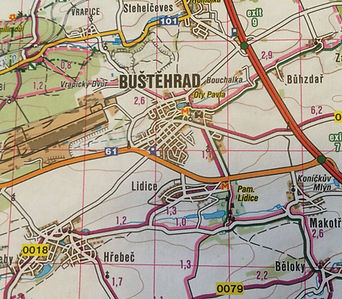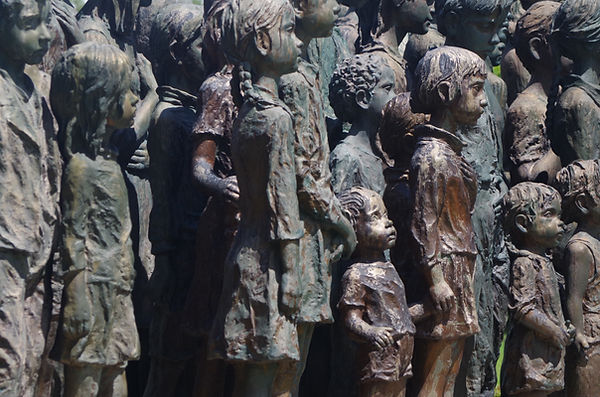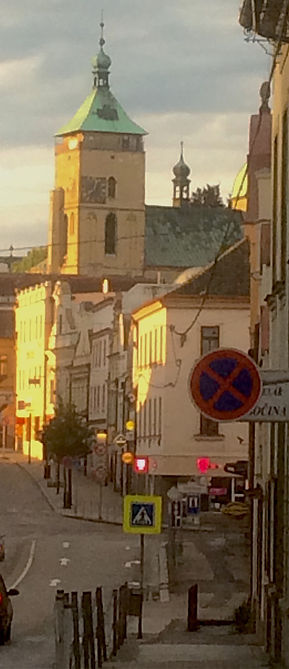
THIS SITE USES GOOGLE ANALYTICS TO ANALYSE TRAFFIC. CONTINUING TO USE THIS SITE MEANS YOU ACCEPT THE USE OF COOKIES.WE DO NOT COLLECT PERSONAL DATA LEARN MORE OR SEE OUR PRIVACY POLICY
SEVEN DAY CYCLIST
CYCLING, BUT NOT USUALLY RACING
LATEST UPDATE NOVEMBER 18th 2025
HOW DO WE REACH THE OVERALL RATINGS FOR PRODUCTS WE REVIEW?
A MISSION TO THE CZECH REPUBLIC
Steve Dyster took his bike to find out more about a half-forgotten link between a village in Bohemia and the miners of North Staffordshire ...
In the good old days, even European travel used to see a bit of bureaucracy and a stamp in the passport at border crossings. Whether the possible return of such happy queueing is to be welcomed is not within the remit of Seven Day Cyclist. Suffice it to say that when I, along with cycling amigo Mark Dally, crossed the border between Germany and the Czech Republic, it was with a disappointing lack of ceremony. A rampant white lion roared, from the arms on the iron posts that marked the border on the west side of the Elbe, that we were now entering “Republika Československa.”
I have never been to a country that does not exist before. Replaced by the Czech Republic and Slovakia in an amiable split that some locals seemed to regret but most just regarded as eminently sensible and fair, there were immediate differences to Germany.
The river changed its name from the German Elbe to the Czech Labe; the language became unfamiliar; the high quality of almost all the riverside cycle paths remained the same.
Czech is not an impossible language, despite the rows of accents above letters and the - to our eyes - apparent infrequency of vowels. However, where a sign suggested that we should divert on a ferry across the river - construction work being undertaken - we were confused enough to ignore it. We’d been diverted across the river shortly before, near Bad Schandau, in Germany. Then we thought we’d been able to make head and tail of what was happening, but had ended up on an MTB route after not taking the next ferry back. So we ignored the Czech warnings and found a crew of men and women repairing the cycle path. They just waved us through and smiled.


Do have a bash at speaking Czech, though. In the Retro Bar in Déčin, it gave the waitress and other customers a good deal of jolly entertainment and got us plates of hearty cuisine and several beers. We are pretty sure it was what we ordered. Google translate helps, but, for friendship and kudos, there is nothing like having a go at the real thing. Later, in Prague, there was generally an English translation, but “up-country” if there was any translation, it was into German.
Oh yes, cycling. We were on our way to Lidice, a village a few miles from Prague. We expected to be there a day and a half after crossing the border. This was, originally, to have been the end of our ride - with Prague airport a few miles away. Not now. An invitation had arrived, from a cycle-tourist by the name of Milan Krčmar. He’d asked us if we would like to ride further into Moravia for a visit to some sites near the town of Trebič. Of course, we had replied positively.

Why cycle from Stoke-on-Trent to a small Czech village - especially with two works of art in the panniers - you might ask? Well. even if you didn’t, here is the back-story.
There were many villages destroyed deliberately by the Nazis during the Second World War. Belarus and Greece suffered horrifically - at least 165 Belarussian villages were torched, generally with their inhabitants locked up in a barn. However, there were acts of arbitrary revenge and hate across Europe. Lidice was one of these. Unusually the whole business was filmed and publicised across Europe, rather than obscured.
Go and see the film Anthropoid, about the mission to kill a prominent Nazi, undertaken by Jan Kubis and Josef Gabcik. In revenge for the assassination of Reinhard Heydrich, Lidice was destroyed - totally. All men over 15 were shot on the morning of June 10th, 1942; all females over 16 were deported to Ravensbruck Concentration Camp, a handful of children were sent to German families, but the other eighty-two were taken to Chelmno, Poland, where they were gassed in the back of converted trucks. The buildings were destroyed and the rubble used to fill in the duck pond, the stream diverted and the cemetery dug-up. “Lidice Shall Die Forever,” declared Adolf Hitler.
In Stoke-on-Trent, Polish immigrant GP and Councillor, Barnett Stross (known in the city as Dr. Bob), declared that “Lidice Shall Live!” So began a worldwide movement, but its backbone was the Federation of North Staffordshire Mineworkers. Led by Arthur Baddeley, they set up a sort of salary-sacrifice scheme. At time of real hardship - pit explosions, shortages and, of course, the war - they managed to raise the equivalent of about one million pounds in today’s money. The village would be rebuilt, the world’s largest rose-garden, a museum, memorials and gallery would ensure that the events of 1942 were not forgotten. A worldwide effort that had its heart-beat in the Potteries. A forgotten story, which many in Stoke-on-Trent would like to be better known.
Oh, yes, cycling. There was only occasional lycra to be seen along the riverbank path. most cyclists were either in loose fitting cycling gear or everyday clothing. The dominant machine was the trekking bike, some with lock-out suspension, but all perfect for the steady pace of most of the tourers. Much better equipped too for the two filthy stretches - each only of a kilometre or so, but dirty enough to stick in mudguard and memory - than our narrower-tyres, drop-barred tourers. Still, we managed.
Heading in the opposite direction, was a sporadic flow of riders travelling from Prague to Dresden, or beyond. The Labe/Elbe cycle route is immensely popular, doing much to boost the tourist businesses along the way. It was obvious that a good deal of money was being invested in infrastructure. Most was very good. When the odd bit of cabbage patch is dealt with, it will be very good. The situation reminded me a bit of our own dear NCN.

Dečin was an excellent first night stop. The Českė Koruna Hotel superb value and obviously popular with the cycle-touring fraternity. Bars and restaurants aplenty. Quite a tourist destination with castle, boat trips and several possible excursions into the surrounding mountains. The river has forced a gorge through the hills and Dečin lies at its heart.
Despite persistent rain, heavy at times, we made rapid progress the next morning, a sound surface taking us through industrial towns and charming countryside, until we eventually popped out of gorge and found ourselves - via those two mud-heaps - approaching Roudnice-nad-Labem. The river looked remarkably full, but we trusted the operators of the huge locks-cum-sluices we had seen on the way up-river.
Getting back on the road was a pretty good feeling. Yep, the setts of the town centres caused some rumblings, but asphalt felt good. A headwind took us a bit by surprise, making the rolling country tougher than expected. Away from the river, as foretold, villages and towns were not as neat and there were few cyclists.
The former coal-mining and steel-making area close to Lidice (many of the village men worked in pits or mills in nearby Kladno, though the village itself had an agricultural heart), felt a bit run-down, though a sudden, cobbled twister of a hill in Buštehrad kept interest up. Then, there was Lidice; museum, gallery, garden, memorials and a neat garden village.


Arranging to present the artworks the next morning, we occupied our room in the hostel attached to the gallery - very cheap, but do check availability in advance. Warm water and cloths were supplied to clean-up mud-spattered bicycles before heading into the bar for a slap-up celebratory dinner.
To describe all that we saw and felt the next day will be a story in itself. Suffice it to say that it is best to set aside the bulk of the day to look around. Don’t fear that it is a village of the dead. The great thing is that Lidice did live and continues to do so. Incongruously - at least, we felt, at first - weddings were taking place in the gardens and people were sun-bathing amongst the memorials where the village had once stood. Children played, families ate ice-cream, and went to the row of shops incorporated in the post-war rebuilding.
The monument to the Child Victims of War is based on images of the Lidice children. Look in the hollow bronze eyes, or stare up at the barbed-wire cross that marks the mass grave of the men, or the memorial to the women sent to Ravensbruck; visit the museum, perhaps the gallery or the old cemetery. “Desperately sorrowful memorial park” springs to mind.


Setting off early next day, we headed through Prague and were doing well until we got lost as a marked trail suddenly disappeared steeply into a forest. It was the right way, but …. The Prague cycle network was actually pretty well-marked and used. However, it is a big city, and it seemed like an age before we finally escaped the ring of tower block flats that seem to encircle many former Soviet-Bloc cities. We noted that we still had a good way to go.
Resorting to the main road was no problem. A Sunday and all was pretty quiet as we ripped the mileage through pleasant countryside all the way to Kuta Hora - definitely a town to go back to when opportunity arises. Generally Czech roads were pretty good. Next day, to make some decent milage in pouring rain, we followed another main road from Havličkuv Brod to Jihlava. This was not a place for the nervous rider nor was it particularly pleasant riding, but it did get the journey broken.
More minor roads were of very mixed surfaces - bit like Britain - but tended to be very quiet. Preferable to cycle routes? Well, that depends on you, but sometimes one felt that all that was needed for a designation as a cycle route was an arrow on a tree pointing into a field. Equally, there were some genuinely fantastic off-road sections through beautiful scenery on fair or fantastic surfaces.

Having cut out the relevant pages from the thorough Cykloatlas Cesko and downloaded some sections using PhoneMaps, we had no shortage of suggested routes. As ever, the surface grading takes a bit of getting used to - even the “passable in dry weather” was open to interpretation! Despite all on offer, when the “official route” along the River Jihlava deteriorated and - as we expected - began to swing wildly up and down the valley sides, we took to the roads.
A well-surfaced country lane would be followed by a rough road where the surface had worn out. Mind, it was a pleasure to ride, winding past an isolated farm surrounded by pastures and thick forest. It was just what one would hope for from Central Europe. Eventually, such brought us down into Trebič, a rattling descent during which it was necessary to tighten the brakes up a bit!
Trebič has two UNESCO World Heritage Sites; its old Jewish Quarter and its Basilica. But we were there to meet Milan Krčmar. Milan works in PR at an alternative energy centre, but is also a touring cyclists. He’d heard about our venture in an interview we did for Czech National Radio, and invited us to come down to find out more.
If you go to the cinema you’ll soon get the chance to see Anthropoid. It’s a film about the plot to assassinate Heydrich. Anthropoid was the code name for the operation carried out by the British Special Operations Executive and a group of Czech officers who had escaped to Britain via Poland and France after 1939. Remember, Czechoslovakia was invaded by Germany in March 1939.
The two officers charged with killing Heydrich were the Czech, Jan Kubiš, and the Slovak, Josef Gabčik. There was no plan of escape, other than to go to ground and wait for the end of the war. Gabčik’s gun jammed, but Kubiš’ grenade had the desired effect. Heydrich died of wounds shortly after.
A huge Wagnerian funeral followed and the inevitable mass arrests and shootings were not far behind. Lidice was singled out through a mixture of factors; sons of residents in the Czech army and airforce in exile, a boastful but false letter meant to impress a girl but delivered to the wrong person, and some vague information about radio sets in the village. Even the local Gestapo could find no real link. Lidice suffered because, in Nazi logic, somewhere had to pay for the death of the man behind the Final Solution.


Kubiš was born in a village “just” over the hill from Trebič. Milan, a tall man with long-legs to lever up the hills, led us. It was a sweltering day and the long descent to Dolni Vilemovice, welcomed at that moment, would have to be climbed on the way back.
A few years ago, there was no museum to the Kubiš family (needless to say, his relatives were singled out for harsh treatment by the vengeful Reich), though a memorial had been erected in the centre of the village. Then the opportunity came to buy and refurbish the old Kubiš house. The community sought funding and the result is a fascinating, well-presented presentation that ranges from great deeds to the handkerchiefs of some of the young Kubiš’ girlfriends; international events mix with the quiet life of a little Moravian village in the 1930s. Even, possibly, most of the families' bicycle.
To help raise awareness and funds for the nascent museum, Milan had ridden from Dolni Vilemovice to Bayswater Road, London, where a blue plaque commemorates the place where the plot was hatched.
By now the mercury had risen even more. We succumbed to the 35 degrees and decided that a two day ride back to Prague across the Bohemian-Moravian Highlands was unnecessary. In any case, we’d reached our destinations by bike and a spare couple of days in Prague beckoned. a train ride would also enable Mark to do a spot of cobbling.
So, we boarded a diesel rattler that bumped and rolled through the hills and sped across the valleys on the way to Brno, the Republic’s second city. A really lovely city, without the extravagant architecture of Prague or the huge crowds of tourists, and good for cycling, we spent a night there before getting the express train to Prague.
On both trains cycle space was plentiful, with hooks to lift bikes onto or designated spaces. A fee has to be paid, but for that you get a reserved space with a specific number linked to your ticket. You may have to lift your bike up the steps from a low level platform. Guards were helpful, but expect to be challenged if you do not have a reservation.



In Prague we arranged to be hosted by a couple of people on the www.warmshowers.com network. If you have not come across this, check it out. Basically, you offer to host and/or ask to be hosted by fellow cycle tourists. Cheap? Yes, but also a good way to meet people who live locally and are full of good advice. Friendly? Yep, hosts tend to be touring cyclists, too.
I am always filled with trepidation when dismantling and boxing my bike up (as required by our carrier) and handing it over at the airport. Our last night host kindly gave us a lift to Prague Airport and all went smoothly, even on the two trains needed to get home from Stansted.
So, take a look at the Czech Republic for a tour. Fascinating history, relaxed people, cheap high-quality beer, many quiet roads and a cycle network that is developing rapidly. You might even visit Lidice and Dolni Vilemovice.
INFORMATION
https://www.czechtourism.com/n/cycle-trails/ deals mainly with trails and routes.
http://www.circuitridercz.com/2011/02/online-cycling-map-of-czech-republic.html is an excellent source of information run by an ex-pat cyclist.
http://www.cykloserver.cz/cykloatlas is a fantastic on-line resource which contains the same information as the Cykloatlas. it is worth reading Circuit Riders article on it before using. Roads are clearly shown, as well as trails. Map sections are available on PnoneMaps, too - very useful with GPs enabled devices.
Trains? https://www.cd.cz/en/ is the website of Ceske Drahy, the national train company. Trains are cheap, though not always frequent on branch lines, and staff helpful, Bikes are carried, but you must buy a bike ticket.
www,warmshowers.org Take a look. if you can’t get away. you can always tour by proxy by hosting fellow cycle-tourers.
www.lidice-memorial.cz/en for the Lidice Memorial complex
Hotels and food are excellent value, though there are many hostels, too. Prague is notably more expensive than the rest of the country, but by no means outrageous if you have ever bought a coca-cola outside Notre Dame or Saint Paul’s.

PUBLISHED AUGUST 2016





